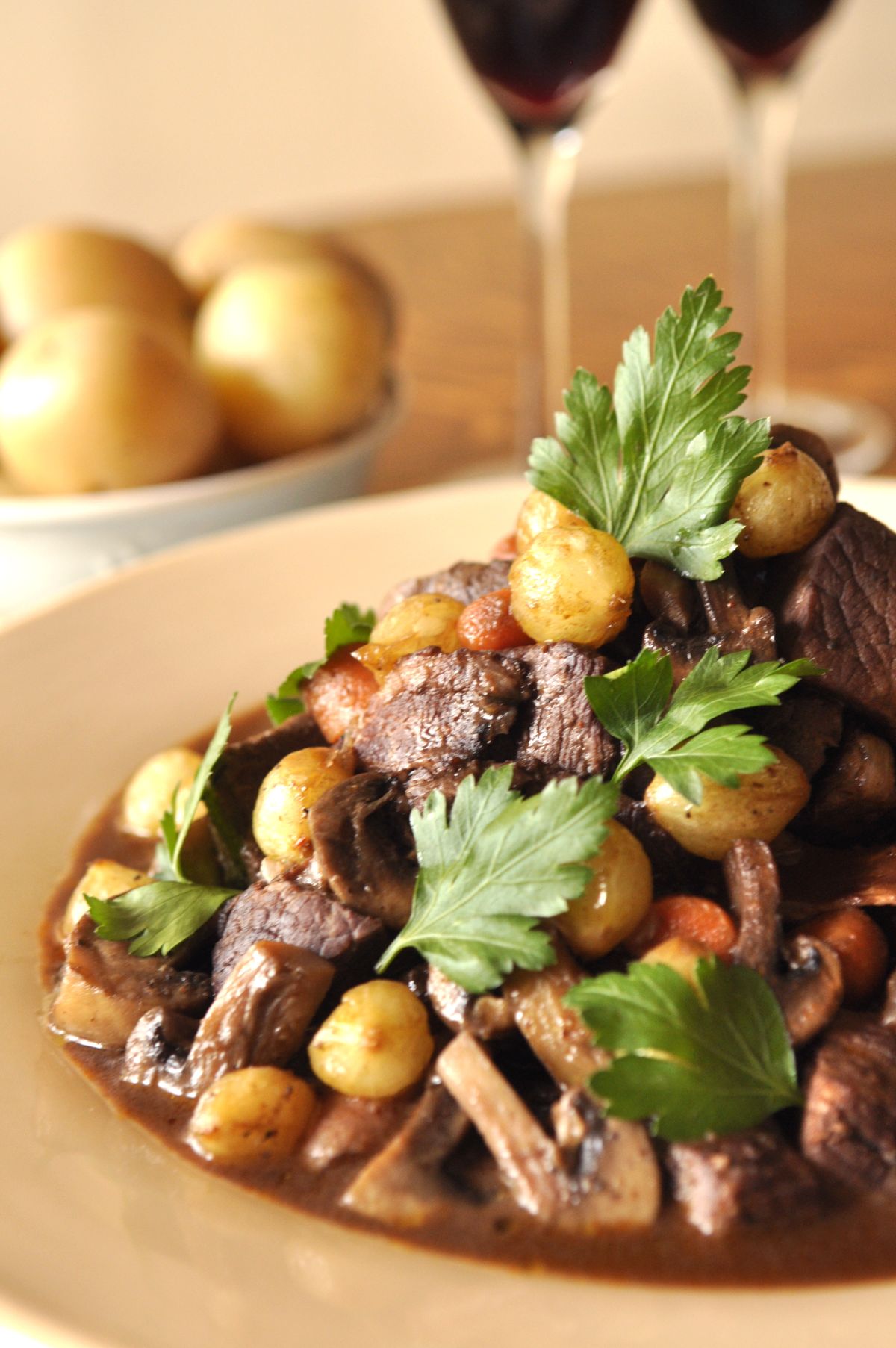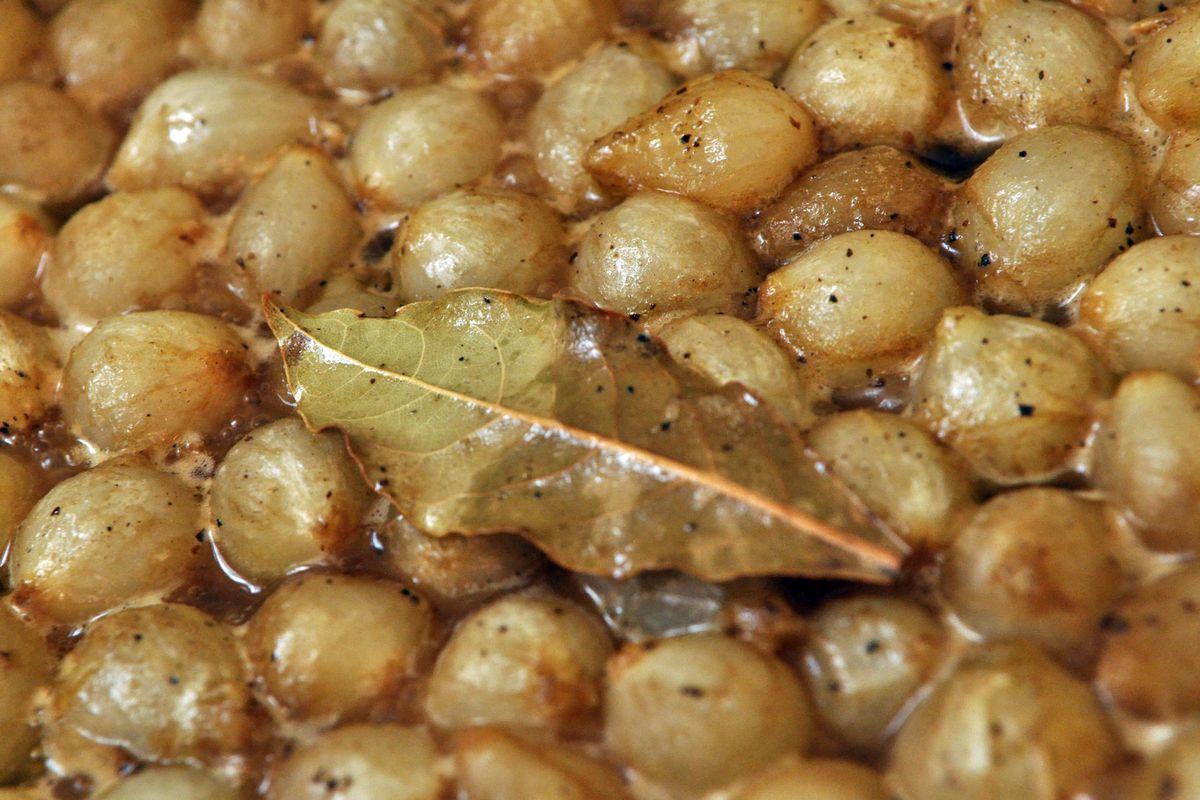Here’s the boeuf
Child’s three-in-one masterpiece is thick, comforting and delicious
Making boeuf bourguignon isn’t nearly as difficult as it is time-consuming. (Adriana Janovich)
Chilly autumn and winter nights beg for warm and hearty dinners like stew.
Boeuf bourguignon – beef in red wine – is a rich and velvety French classic, made famous for American home cooks by Julia Child.
She prepared the dish during the first episode of her television show, “The French Chef,” in 1963.
In her cookbook, “Mastering the Art of French Cooking,” published two years earlier, Child called it “one of the most delicious beef dishes concocted by man.”
Thick, comforting and long-simmering, it’s perfect for unhurried weekends when temperatures dip and the warmth of home keeps people indoors.
The recipe can seem daunting. It’s really three – boeuf bourguignon, brown-braised onions and sautéed mushrooms – in one.
But it isn’t so much difficult as it is time-consuming.
Originally a peasant dish from the Burgundy region, boeuf bourguignon has become traditional French cuisine. Some hard-core home cooks will spend three days on the dish: one for making their own beef stock, another for braising and cooking the meat, and still another for preparing the onions and mushrooms for garnish.
I dedicated about four hours to this dish on a recent Sunday afternoon and, for a first-timer who made a few rookie mistakes, was still extremely pleased with the flavorful results.
The beef was fork-tender. The mushrooms, buttery. The sauce, silky.
Served with simple boiled potatoes, it made for a decadent and filling autumn meal.
The recipe in the book differs slightly from the one on the cooking show’s premiere, which can be found on YouTube and serves as a helpful resource. I read through the recipe before getting started and referred to it often throughout the cooking process. But if I could do it over, I would watch the full episode as well as read the instructions before undertaking the recipe.
I didn’t get the beef “good and dry” enough. Same thing goes for the mushrooms. And in the TV show, Child discussed the mushrooms at length.
“A properly sautéed mushroom doesn’t have any juice,” she said, demonstrating the process of patting dry the fungi, then waiting for the butter foam to dissipate, signaling the skillet is hot enough for sautéing.
Child offers words of wisdom, like “Don’t crowd the pan,” and, “You have to be a little bit patient if you want success.”
On the show, she uses a full bay leaf; the recipe in the book calls for a crumbled bay leaf.
The recipe in the book also calls for flour while the stew cooks in the oven; on the show, Child added flour to the sauce in a saucepan over a burner at the end of the process.
She browned the meat on the show in olive oil instead of the mixture of bacon fat and oil for which the book calls.
And, in the show, Child didn’t appear to use bacon or carrots, both of which are included in the recipe in the book, which includes a cooking time of 2 ½ to 3 hours in the oven. On the show, Child recommends 3 to 4 hours.
She did write, in the introduction to the recipe in the book, “As is the case with most famous dishes, there are more ways than one to arrive at a good boeuf bourguignon.”
I’m looking forward to tinkering with it in the years to come. I’m already thinking of adding the carrots to the pot later in the cooking process; after 2 ½ or 3 hours in the oven, they become a little mushy.
Still, as Child said, “It’s a lovely dish.”
And leftovers only seem to gain richness and flavor.
Boeuf Bourguignon
From “Mastering the Art of French Cooking,” by Julia Child
I used Chianti, like Child suggested. I also crumbled the bay leaf as directed in the recipe in the cookbook, but next time I’ll just throw a whole leaf (or two) into the pot, like Child did when she made this dish on her cooking show. Because the bacon I used came pre-sliced, I didn’t have a rind to blanch. Other than that – and my rookie mistake of not drying the beef or mushrooms enough – I followed these instructions and savored the results.
6 ounces bacon
1 tablespoon olive oil or cooking oil
3 pounds lean stewing beef, cut into 2-inch cubes
1 sliced carrot
1 sliced onion
1 teaspoon salt
1/4 teaspoon pepper
2 tablespoon flour
3 cups full-bodied, young red wine, such as Chianti
2 to 3 cups brown beef stock or canned beef bouillon
1 tablespoon tomato paste
2 cloves mashed garlic
1/2 teaspoon thyme
Crumbled bay leaf
Blanched bacon rind
18 to 24 small white onions, brown-braised in stock (See recipe below.)
1 pound quartered fresh mushrooms, sautéed in butter (See recipe below.)
Parsley sprigs
Remove rind from bacon, and cut bacon into lardons (sticks, ¼-inch thick and 1 ½ inches long). Simmer rind and bacon for 10 minutes in 1 ½ quarts of water. Drain and dry.
Preheat oven to 450 degrees.
Sauté the bacon in the oil in a 9- to 10-inch, fireproof casserole dish, 3 inches deep, over moderate heat for 2 to 3 minutes to brown lightly. Remove to a side dish with a slotted spoon. Set casserole aside.
Dry the stewing beef in paper towels; it will not brown if it is damp. Reheat fat until it’s almost smoking. Sauté the beef, a few pieces at a time, in the hot oil and bacon fat until nicely browned on all sides. Add it to the bacon.
In the same fat, brown the sliced vegetables.
Pour out the sautéing fat.
Return the beef and bacon to the casserole and toss with the salt and pepper. Then sprinkle on the flour and toss again to coat the beef lightly with the flour. Set casserole uncovered in middle position of preheated oven for 4 minutes. Toss the meat and return to oven for 4 minutes more. (This browns the flour and covers the meat with a light crust.)
Remove casserole, and turn oven down to 325 degrees.
Stir in the wine, and enough stock or bouillon so that the meat is barely covered. Add the tomato paste, garlic, herbs and bacon rind. Bring to simmer on top of the stove. Then cover the casserole and set in lower third of preheated oven. Regulate heat so liquid simmers very slowly for 2 ½ to 3 hours. The meat is done when a fork pierces it easily.
While the beef is cooking, prepare the onions and mushrooms. Set them aside until needed.
When the meat is tender, pour the contents of the casserole into a sieve set over a saucepan. Wash out the casserole and return the beef and bacon to it. Distribute the cooked onions and mushrooms over the meat.
Skim fat off the sauce. Simmer sauce for a minute or two, skimming off additional fat as it rises. You should have about 2 ½ cups of sauce thick enough to coat a spoon lightly. If too thin, boil it down rapidly. If too thick, mix in a few tablespoons of stock or canned bouillon. Taste carefully for seasoning. Pour the sauce over the meat and vegetables. Recipe may be completed in advance to this point.
For immediate serving: Cover the casserole and simmer for 2 to 3 minutes, basting the meat and vegetables with the sauce several times. Serve in its casserole, or arrange the stew on a platter surrounded with potatoes, noodles, or rice, and decorated with parsley.
For later serving: When cold, cover and refrigerate. About 15 to 20 minutes before serving, bring to a simmer, cover, and simmer very slowly for 10 minutes, occasionally basting the meat and vegetables with the sauce.
Serves: 6
Brown-braised Onions
From “Mastering the Art of French Cooking,” by Julia Child
I used brown beef stock and a full bay leaf.
1 1/2 tablespoons butter
1 1/2 tablespoons oil
18 to 24 peeled white onions about 1 inch in diameter
1/2 cup of brown stock, canned beef bouillon, dry white wine, red wine, or water
Salt and pepper to taste
A medium herb bouquet: 4 parsley sprigs, 1/2 bay leaf, and 1/4 teaspoon thyme, tied in cheesecloth
When the butter and oil are bubbling in a 9- to 10-inch enameled skillet, add the onions and sauté over moderate heat for about 10 minutes, rolling the onions about so they will brown as evenly as possible. Be careful not to break their skins. You cannot expect to brown them uniformly.
Then braise them as follows: Pour in the liquid, season to taste, and add the herb bouquet. Cover and simmer slowly for 40 to 50 minutes until the onions are perfectly tender but retain their shape, and the liquid has evaporated. Remove herb bouquet.
Or, bake them as follows: Transfer the onions and their sautéing fat to a shallow baking dish or casserole just large enough to hold them in one layer. Set uncovered in upper third of a preheated 350-degree oven for 40 to 50 minutes, turning them over once or twice. They should be very tender, retain their shape, and be a nice golden brown. Remove herb bouquet.
The onions may be cooked hours in advance, and reheated before serving.
Sautéed Mushrooms
From “Mastering the Art of French Cooking,” by Julia Child
Successfully sautéed mushrooms are lightly browned and exude none of their juice while they are being cooked; to achieve this, the mushrooms must be dry, the butter very hot, and the mushrooms must not be crowded in the pan. If you sauté too many at once they steam rather than fry; their juices escape and they do not brown. So if you are preparing a large amount, or if your heat source is feeble, sauté the mushrooms in several batches.
2 tablespoons butter
1 tablespoon oil
1/2 pound fresh mushrooms, washed, well dried, left whole if small, sliced or quartered if large
Optional: 1 to 2 tablespoons minced shallots or green onions
Salt and pepper
Place 10-inch enameled skillet over high heat with the butter and oil. As soon as you see that the butter foam has begun to subside, indicating it is hot enough, add the mushrooms. Toss and shake the pan for 4 to 5 minutes. During their sauté the mushrooms will at first absorb the fat. In 2 to 3 minutes the fat will reappear on their surface, and the mushrooms will begin to brown. As soon as they have browned lightly, remove from heat.
Toss the shallots or green onions with the mushrooms. Sauté over moderate heat for 2 minutes.
Sautéed mushrooms may be cooked in advance, set aside, then reheated when needed. Season to taste just before serving.



